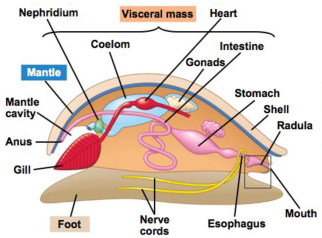Anatomy
Visceral organs show well organised features which include a nervous system, heart and circulatory system, digestive and excretory system, and a reproductive system (Archerd Shell Collection, 2014). The nervous system is twisted into a visceral loop due to the effects of torsion (Ruppert et. al, 2004). This affects the location of the ganglion, which means the system is no longer concentrated, and is separated by long connectives that are distant from each other (Ruppert et. al, 2004). This delays the communication time between ganglia (Ruppert et. al, 2004).
The circulatory system is comprised of a hemal system that includes a single muscular atrium (Ruppert et. al, 2004). It is an open system in which blood is pumped into an open haemocoel (not lined by endothelium) and is diffused back into the circulatory system (Archerd Shell Collection, 2014). Blood is pumped by the heart into the body cavities (Ruppert et. al, 2004). An open circulatory system affects the mobility of the organism,being associated with slow movements and a lower metabolic rate (The Circulatory System, 2013).
Digestion is extracellular, in which enzymes breakdown food into molecules small enough to be taken up by diffusion, transport or phagocytosis (Ruppert et. al, 2004). The radula is used to rasp along surfaces when scouring for food (Ruppert et. al, 2004). When extended, food obtained by the radula is mixed with mucus where it is then channelled through the esophagus and into the stomach after retraction (Ruppert et. al, 2004).
Excretion occurs via the nephridia, a blind sac that is surrounded by the hemocoel (Ruppert et. al, 2004). The nephridiopore opens at the rear of the mantle cavity and is downstream of the gills (Ruppert et. al, 2004). Waste is removed by the respiratory water current and is comprised of ammonia that is the end product of their protein metabolism (Ruppert et. al, 2004).
 General internal anatomy of a gastropod (BIOL221, 2013).
General internal anatomy of a gastropod (BIOL221, 2013).
|